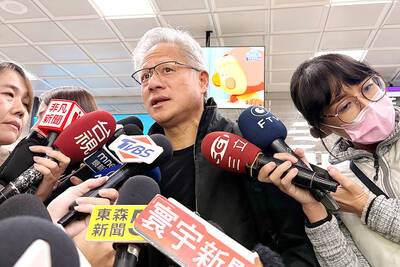The nation’s leading contract notebook computer manufacturers should see shipments regain growth momentum this quarter, after shipments weakened last quarter due to supply constraints and the effect of the Lunar New Year holiday, local media reported last week.
However, it remains unclear how shipments from the nation’s five major notebook computer original design manufacturers (ODMs) would fare in the second half of the year, amid uncertainty over possible key component shortages, logistics bottlenecks due to COVID-19 lockdowns and rising inflationary pressure, the reports said.
The five companies are Quanta Computer Inc (廣達), Compal Electronics Inc (仁寶), Wistron Corp (緯創), Inventec Corp (英華達) and Pegatron Corp (和碩). As Taiwan’s notebook computer ODMs account for more than 90 percent of global production, their shipment momentum has a high correlation with the dynamic of the global market.

Photo: Reuters
Global notebook computer shipments grew 19 percent year-on-year to 268 million units last year because of strong commercial demand in the final quarter of the year, Boston-based research firm Strategy Analytics said in a report on Jan. 31.
Strategy Analytics attributed the fourth-quarter performance to Windows 11 enterprise upgrades, which gave Windows notebook computers a boost during the quarter across all regions, despite a slowdown in Chromebook demand in the second half of last year.
In the first quarter of this year, shipments from the nation’s top five notebook ODMs reached 41.6 million to 41.7 million units, representing a quarterly decrease of nearly 20 percent, according to data compiled from the companies’ latest revenue updates released on Friday.
Quanta, the world’s largest contract notebook maker, shipped 16.9 million units last quarter, down 15 percent quarterly and 11 percent annually, while Compal, the world’s No. 2 contract laptop maker, reported shipments of 11.8 million units, down 26.7 percent from the previous quarter and 9.9 percent lower than a year earlier, company data showed.
Wistron, Inventec and Pegatron reported shipments of 5.6 million, 5 million and 2.3 million to 2.4 million units respectively, down 25.66 percent, 10.71 percent and 20 percent from the previous quarter.
On a yearly basis, the three makers’ shipments increased from 3.7 percent to 5 percent, as demand for hybrid work environments supported the developed market’s growth, while customers’ shift toward mobility boosted the emerging market.
The five ODMs said they have clear order visibility through the end of the first half of the year, with Inventec expecting a slight growth in notebook shipments this quarter, while Compal and Wistron forecast shipments would grow about 10 percent compared with the first quarter.
Pegatron also maintained its previous forecast and estimated that second-quarter shipments would increase by 25 to 30 percent from the first quarter, but Quanta said it was difficult to provide guidance for second-quarter shipments due to uncertainties.
Given the lingering shortage of key components and lockdowns in Shanghai and Kunshan, China, the five ODMs said that the adverse effects from the disease prevention measures on the notebook computer supply chain were expected to emerge later this month, local media reported.
Russia’s invasion of Ukraine would also affect the European market, while rising global inflation and port congestion would also impact shipments in the second half of the year, the companies said.

Nissan Motor Co has agreed to sell its global headquarters in Yokohama for ¥97 billion (US$630 million) to a group sponsored by Taiwanese autoparts maker Minth Group (敏實集團), as the struggling automaker seeks to shore up its financial position. The acquisition is led by a special purchase company managed by KJR Management Ltd, a Japanese real-estate unit of private equity giant KKR & Co, people familiar with the matter said. KJR said it would act as asset manager together with Mizuho Real Estate Management Co. Nissan is undergoing a broad cost-cutting campaign by eliminating jobs and shuttering plants as it grapples

TEMPORARY TRUCE: China has made concessions to ease rare earth trade controls, among others, while Washington holds fire on a 100% tariff on all Chinese goods China is effectively suspending implementation of additional export controls on rare earth metals and terminating investigations targeting US companies in the semiconductor supply chain, the White House announced. The White House on Saturday issued a fact sheet outlining some details of the trade pact agreed to earlier in the week by US President Donald Trump and Chinese President Xi Jinping (習近平) that aimed to ease tensions between the world’s two largest economies. Under the deal, China is to issue general licenses valid for exports of rare earths, gallium, germanium, antimony and graphite “for the benefit of US end users and their suppliers

PERSISTENT RUMORS: Nvidia’s CEO said the firm is not in talks to sell AI chips to China, but he would welcome a change in US policy barring the activity Nvidia Corp CEO Jensen Huang (黃仁勳) said his company is not in discussions to sell its Blackwell artificial intelligence (AI) chips to Chinese firms, waving off speculation it is trying to engineer a return to the world’s largest semiconductor market. Huang, who arrived in Taiwan yesterday ahead of meetings with longtime partner Taiwan Semiconductor Manufacturing Co (TSMC, 台積電), took the opportunity to clarify recent comments about the US-China AI race. The Nvidia head caused a stir in an interview this week with the Financial Times, in which he was quoted as saying “China will win” the AI race. Huang yesterday said

Dutch chipmaker Nexperia BV’s China unit yesterday said that it had established sufficient inventories of finished goods and works-in-progress, and that its supply chain remained secure and stable after its parent halted wafer supplies. The Dutch company suspended supplies of wafers to its Chinese assembly plant a week ago, calling it “a direct consequence of the local management’s recent failure to comply with the agreed contractual payment terms,” Reuters reported on Friday last week. Its China unit called Nexperia’s suspension “unilateral” and “extremely irresponsible,” adding that the Dutch parent’s claim about contractual payment was “misleading and highly deceptive,” according to a statement